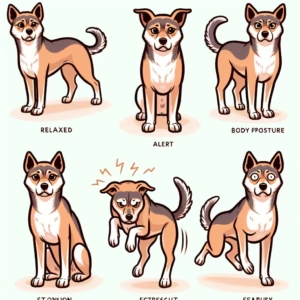How Dogs Recognize Human Emotions: A Complete Guide to Canine Emotional Intelligence
Have you ever gazed into your dog’s eyes during a moment of sadness and felt like they truly understood what you were feeling? That uncanny connection isn’t just wishful thinking-it’s backed by fascinating scientific research.
Dogs possess remarkable emotional intelligence that allows them not only to recognize human emotions but to respond to them in meaningful ways.
The bond between humans and dogs stretches back thousands of years, evolving from a practical partnership into one of the most emotionally nuanced relationships between different species.
This extraordinary connection isn’t merely about companionship; it represents a sophisticated interplay of perception, understanding, and response that continues to amaze researchers.
In this comprehensive exploration, we’ll delve into the remarkable world of canine emotional intelligence, examining how dogs perceive our feelings, how they process this information, and why this ability makes them such exceptional companions in our lives.
We’ll also explore groundbreaking 2025 research that reveals how humans often misinterpret their dogs’ emotional states and what this means for strengthening the human-canine bond.
The Science Behind Canine Emotional Intelligence
Emotional intelligence in dogs isn’t just a charming trait-it’s a complex cognitive ability that has developed through thousands of years of coexistence with humans.
This sophisticated capacity enables dogs to recognize, interpret, and respond appropriately to emotions in both themselves and others, particularly their human companions.
Evolution of Dogs’ Emotional Perception
The emotional intelligence we observe in modern dogs didn’t appear overnight. Through the domestication process, dogs that could better understand human emotional cues likely received preferential treatment, creating an evolutionary advantage.
This selective pressure gradually enhanced dogs’ ability to read human emotions.
What makes this ability particularly remarkable is that dogs can recognize emotions not just in other dogs but across species barriers. This cross-species emotional recognition is relatively rare in the animal kingdom and highlights the unique evolutionary path dogs have taken alongside humans.
The domestication process has essentially created an animal uniquely attuned to human emotional states.
While wolves-dogs’ wild ancestors-show some ability to read conspecific emotions, domestic dogs have developed specialized skills for interpreting human emotional expressions that go far beyond what’s observed in their wild counterparts.
Brain Activity and Emotional Processing in Dogs
Recent advances in canine neuroscience have provided fascinating insights into how dogs process emotional information. Brain imaging studies reveal that dogs have specialized neural regions dedicated to processing social information and emotions, similar to humans.
When dogs observe human emotional expressions, these specialized brain regions activate in patterns that suggest they’re not simply responding to visual features but actually processing the emotional content.
For instance, when dogs are presented with happy versus angry human faces, different patterns of brain activity emerge. These patterns indicate that dogs aren’t merely distinguishing between different facial configurations but are actually processing the emotional significance behind these expressions.
Particularly interesting is how dogs process the scent of familiar humans. Research using functional Magnetic Resonance Imaging (fMRI) has shown that dogs’ brains respond more actively to their owners’ scents than to other stimuli, highlighting the depth of their emotional connection to specific humans. This neurological response reinforces what many dog owners intuitively feel-that their dogs have a special emotional bond with them.
How Dogs Recognize Human Emotions
Dogs employ multiple sensory channels to perceive human emotions, creating a rich, multidimensional understanding of how we feel. This multi-modal perception allows them to gather emotional information through various means, making their emotional intelligence particularly robust.
Visual Recognition: Reading Facial Expressions
Dogs demonstrate remarkable abilities to distinguish between different human facial expressions. Research has shown that they can recognize six basic human emotions: anger, fear, happiness, sadness, surprise, and disgust. This recognition isn’t simply a learned response to visual patterns-dogs appear to understand the emotional significance behind these expressions.
In groundbreaking studies, researchers found that dogs can differentiate between positive and negative emotions based solely on human facial expressions. When presented with images of human faces displaying different emotions, dogs showed distinct behavioral responses depending on the emotional content of the image.
What’s particularly impressive is that dogs can recognize emotional expressions even when they’re only shown partial faces. In one study, dogs trained to recognize happy or angry expressions using only the top half of unfamiliar faces could still identify the emotion when shown only the bottom half. This suggests they understand the holistic nature of emotional expressions rather than simply responding to isolated visual features.
Auditory Recognition: Interpreting Vocal Tones
Dogs don’t just read emotions from faces-they’re also highly sensitive to emotional cues in human vocalizations. Research has demonstrated that dogs respond differently to human vocalizations depending on their emotional content, regardless of the actual words being spoken.
This sensitivity to vocal emotional cues appears early in a dog’s development and doesn’t require extensive training. Even puppies show differential responses to emotionally charged human vocalizations, suggesting this ability may be partially innate rather than entirely learned.
Particularly interesting is dogs’ response to human distress vocalizations. Studies have found that dogs respond more strongly to human crying than to other environmental sounds, suggesting a specialized sensitivity to human emotional distress.
This heightened response to human distress vocalizations may have evolved as part of dogs’ adaptation to human social groups, where recognizing and responding to human distress could strengthen social bonds.
Cross-Modal Integration of Emotional Cues
Perhaps most impressive is dogs’ ability to integrate emotional information across different sensory modalities. They don’t just process visual and auditory emotional cues separately-they can combine this information into a coherent perception of emotion.
In a groundbreaking study published in Biology Letters, researchers presented dogs with either human or dog faces displaying different emotional expressions (happy/playful versus angry/aggressive) paired with vocalizations that either matched or mismatched the facial expression.
Dogs looked significantly longer at the face whose expression matched the emotional valence of the vocalization, for both dogs and humans. This demonstrates that dogs can extract and integrate bimodal sensory emotional information, creating a unified perception of emotional states.
This cross-modal integration of emotional cues was previously thought to exist only in humans and some non-human primates, making this discovery particularly significant. It suggests that dogs possess sophisticated cognitive representations of emotions that allow them to recognize emotional content across different sensory channels and integrate this information meaningfully.
What makes this ability even more remarkable is that the dogs in the study performed this integration without any training or familiarization with the models, suggesting that these emotional signals are intrinsically important to dogs.
The relationship between the visual and auditory cues wasn’t temporally contiguous (for example, a relaxed dog face with open mouth paired with a playful bark recorded at a different time), reducing the likelihood that the dogs were simply responding based on learned associations.
The Human Misperception of Dog Emotions: 2025 Research Findings
While dogs excel at understanding our emotions, recent research from March 2025 reveals that humans often misinterpret their dogs’ emotional states. This groundbreaking study provides critical insights into how we can better understand our canine companions.
Context Over Behavior: How We Misread Our Dogs
The 2025 research found that humans typically judge a dog’s emotions based on the context surrounding the dog rather than the dog’s actual behavior. In their experiments, participants watched videos of dogs in positive situations (like receiving treats or seeing a leash) and negative situations (like being scolded or hearing a vacuum cleaner).
What they discovered was surprising: people consistently based their perception of the dog’s emotional state on the surrounding context rather than on the dog’s actual behavioral cues.
For example, when people saw a dog apparently reacting to a vacuum cleaner, they universally reported that the dog was feeling bad and agitated. However, when they saw the exact same dog behavior but in the context of seeing a leash, they reported the dog was feeling happy and calm.
In their second experiment, the researchers created videos where the dog’s behavior remained identical but the context was altered. Even when the dog was displaying the exact same behavior, participants judged the dog’s emotions based on what the human was doing in the video rather than on the dog’s actual behavior.
This demonstrates how strongly our perceptions of dog emotions are influenced by contextual factors rather than the dog’s actual emotional signals.
The Impact of Anthropomorphizing on Understanding Dog Emotions
Another key finding from the 2025 research is that humans tend to project their own emotions onto dogs, a phenomenon known as anthropomorphizing. While humans and dogs have shared a close bond for centuries, this doesn’t mean they process or express emotions in the same way.
This projection of human emotions onto dogs further complicates our ability to accurately understand what our dogs are trying to communicate.
The research suggests that to better understand our dogs’ true emotional states, we need to focus directly on their specific behavioral cues rather than making assumptions based on the situation or projecting our own feelings onto them.
This means paying close attention to body language, vocalizations, and facial expressions rather than interpreting emotions based on what we think the dog should be feeling in a given context.
Reading Your Dog: Understanding Canine Emotional Cues
To better understand what your dog is actually feeling, it’s essential to learn how to read their specific behavioral cues. Dogs communicate their emotional states primarily through body language, and learning to recognize these signals can significantly improve your relationship with your canine companion.
Body Language Indicators of Different Emotional States
Dogs express a range of emotions through their body language, with different emotional states characterized by distinct sets of behavioral cues:
Relaxed and Happy
- Loose body posture: When your dog is relaxed, there’s no tension in their muscles, and their movements are smooth, indicating they feel comfortable and safe.
- Gentle tail wagging: A relaxed tail wag in a neutral or lower position shows contentment. Note that not all tail wagging indicates happiness-the stiffness and position of the tail, along with other body signals, help determine what your dog is feeling.
- Open mouth and soft eyes: A relaxed dog may have a slightly open mouth (sometimes appearing as a “smile”) with soft, slow-blinking eyes, indicating they feel at peace.
Alert and Curious
- Ears forward or perked: When curious, dogs often direct their ears toward the area of interest, showing they’re paying close attention.
- Tail up but not stiff: A curious dog might hold their tail higher than normal, but it won’t be rigid. This signals attention without feeling threatened.
- Head tilting or focused gaze: The classic head tilt or fixed attention on something specific indicates your dog is processing new information.
Stressed or Anxious
- Pacing and panting: If your dog paces back and forth or pants heavily in a cool environment, they’re likely feeling anxious or overwhelmed.
- Licking lips or yawning: While these can seem like normal behaviors, they often indicate discomfort and serve as self-soothing techniques in stressful situations.
- Tucked tail: One of the clearest signs of fear or anxiety is when a dog tucks their tail between their legs, signaling they feel threatened.
- Pinned back ears: Ears flattened against the head indicate discomfort and a desire to escape the current situation.
Fearful or Aggressive
- Stiff body and rigid tail: When a dog’s body tenses up with their tail held high and stiff, they’re feeling scared, threatened, or defensive and may be preparing to react.
- Growling or baring teeth: These more obvious signs indicate your dog is feeling scared or defensive and wants the perceived threat to back off.
- Hard stare: An intense, prolonged gaze at a person or another animal often precedes more aggressive behavior and signals you should remove your dog from the situation to avoid conflict.
Vocalizations and Their Emotional Meanings
In addition to body language, dogs communicate through various vocalizations that can provide insight into their emotional state:
- Barking: Different types of barks can indicate different emotions. Short, sharp barks often signal alertness or excitement, while continuous rapid barking may indicate distress or alarm.
- Whining: This can indicate anxiety, excitement, or a desire for attention, depending on the context and accompanying body language.
- Growling: Usually a warning sign indicating fear, discomfort, or a request for more space.
- Howling: Can express loneliness, response to certain sounds, or communication with other dogs.
- Sighing: Often indicates contentment or mild disappointment, depending on the context.
Understanding these cues allows you to respond appropriately to your dog’s emotional needs, strengthening your bond and ensuring their wellbeing.
The Empathetic Response: How Dogs React to Human Emotions
Once dogs perceive human emotions, they often respond in ways that suggest not just recognition but a form of emotional resonance. These responses can range from subtle behavioral changes to more obvious attempts at interaction based on the emotional context.
Behavioral Changes Based on Owner’s Emotional State
Dogs modify their behavior significantly based on their perception of their owner’s emotional state. Research has shown that when owners display different emotions, dogs adjust their behavior accordingly, suggesting they not only recognize the emotion but understand its implications.
For example, when owners display negative emotions like sadness, dogs often exhibit behaviors such as decreased activity, reduced playfulness, and increased attention toward their owner. Conversely, when owners display positive emotions like happiness, dogs typically show increased activity, more playful behaviors, and greater engagement with their surroundings.
These behavioral adjustments aren’t random-they appear tailored to the specific emotional context, suggesting dogs have developed sophisticated responses to different human emotional states. This adaptability allows dogs to respond appropriately in various emotional situations, strengthening their bond with humans.
Performance and Compliance Variations
Interestingly, a dog’s performance on tasks and their compliance with commands varies significantly depending on their owner’s emotional state. Recent research found that dogs performed better at training tasks when their owners were happy compared to when they were sad or emotionally neutral.
In one study, dogs were less compliant with the “sit” command when learning a new task from a sad owner. They also gazed and jumped less frequently in this condition. This suggests that dogs not only perceive their owner’s emotional state but that this perception influences their motivation and ability to engage with training tasks.
These findings have important implications for dog training approaches. They suggest that a trainer’s emotional state significantly impacts training effectiveness, with positive emotional states facilitating better learning and performance from dogs.
Comfort-Seeking vs. Comfort-Providing Behaviors
While many dog owners report that their dogs provide comfort during times of distress, research presents a more nuanced picture. Some studies suggest that rather than actively providing comfort, dogs may actually distance themselves when their owners are sad.
This behavior doesn’t necessarily indicate a lack of empathy but may reflect dogs’ own emotional response to human distress. Just as humans sometimes feel uncomfortable around others’ strong negative emotions, dogs may experience similar discomfort. Alternatively, this behavior might represent a self-protective response, as negative emotions can sometimes signal potential threats or unpredictable situations.
However, individual dogs vary greatly in their responses to human emotions. Some dogs do indeed show behaviors that appear comforting, such as increased physical contact or attentiveness during times of owner distress. These individual differences likely reflect a combination of genetic predispositions, early life experiences, and the specific relationship between the dog and owner.
The Functional Value of Emotional Intelligence in Dogs
Dogs’ ability to recognize and respond to human emotions isn’t merely an interesting cognitive trick-it serves important functional purposes in their lives. This emotional intelligence helps dogs navigate their social environment and strengthen their bonds with humans.
Adaptation to Multi-Species Social Groups
Modern dogs typically live in multi-species social groups (families) where understanding human emotions is crucial for successful integration. By accurately perceiving human emotional states, dogs can adjust their behavior appropriately, avoiding conflicts and strengthening social bonds.
This adaptive function likely played a key role in dogs’ domestication process. Dogs that could better understand and respond to human emotions would have been more successful in human social groups, receiving better care and having more opportunities to reproduce. Over generations, this selection pressure would have enhanced dogs’ emotional intelligence, creating the remarkably perceptive companions we know today.
The functional value of emotional intelligence extends beyond basic survival. By understanding human emotions, dogs can anticipate human behavior, respond appropriately to changing situations, and form deeper bonds with their human companions. This emotional attunement creates a feedback loop where stronger bonds lead to better care, further enhancing the dog’s wellbeing and reproductive success.
Problem-Solving Using Emotional Information
Dogs don’t just passively recognize emotions-they actively use this emotional information to solve problems and make decisions. Research has shown that dogs can infer potential consequences from human emotional displays and adjust their behavior accordingly.
In one fascinating study, dogs were able to use the emotional information obtained from people in a functional way when faced with a social problem. They paid attention to human emotional cues, obtained information from these cues, and used this information to adjust their behavior appropriately. Moreover, they showed the ability to use previously stored information about human emotional expressions to infer people’s emotional states.
This problem-solving ability demonstrates that dogs’ emotional intelligence goes beyond simple recognition. They can make sophisticated inferences based on emotional information and use these inferences to guide their behavior in complex social situations. This capacity allows dogs to navigate the human social world with remarkable success, despite the cross-species communication challenges.
Strengthening the Human-Dog Emotional Bond
Understanding dogs’ emotional intelligence opens new possibilities for strengthening the human-dog relationship. By recognizing and respecting dogs’ emotional capacities, we can create more fulfilling relationships with our canine companions.
Training Approaches That Consider Emotional Intelligence
Traditional dog training often focuses primarily on behavioral outcomes, sometimes overlooking the emotional dimension of the human-dog relationship. However, training approaches that acknowledge and utilize dogs’ emotional intelligence can be more effective and create stronger bonds.
Positive reinforcement training methods align well with dogs’ emotional intelligence. By creating positive emotional associations with desired behaviors, these methods leverage dogs’ ability to perceive and respond to human emotions. When trainers display positive emotions during training sessions, dogs typically perform better and learn more quickly.
Conversely, training methods that rely on punishment or intimidation can damage the emotional bond between dogs and humans. Since dogs are highly sensitive to human emotional states, negative emotional displays during training can create fear and anxiety, undermining trust and hindering learning.
Understanding that dogs perceive and respond to our emotions during training sessions can transform our approach. By maintaining a positive emotional state while training, we can enhance dogs’ learning and strengthen our emotional connection simultaneously.
Creating Positive Emotional Environments
Beyond specific training contexts, the overall emotional environment we create for our dogs significantly impacts their wellbeing and behavior. Dogs thrive in environments where they can accurately predict human emotional responses and where positive emotions predominate.
Consistency in emotional expression helps dogs feel secure. When human emotional responses are unpredictable or extreme, dogs may become anxious or confused, unable to determine appropriate behavioral responses. By maintaining emotional consistency and clearly communicating our expectations, we help dogs navigate their social environment successfully.
Creating opportunities for positive emotional experiences strengthens the human-dog bond. Activities that generate positive emotions for both species-such as play, exploration, and relaxed physical contact-build emotional connections and reinforce dogs’ positive associations with human interaction.
Understanding dogs’ emotional intelligence also means recognizing when they might be overwhelmed by emotional stimuli. In emotionally charged situations, dogs may need space or support to process their responses. Respecting these needs demonstrates emotional reciprocity and deepens mutual trust.
The human-dog relationship represents one of the most successful cross-species bonds in history, built on a foundation of emotional connection and mutual understanding. By appreciating and nurturing dogs’ emotional intelligence, we honor this extraordinary relationship and create opportunities for even deeper connections with our canine companions.
Share Your Experience: Understanding Your Dog’s Emotional Intelligence
We’d love to hear about your experiences with your dog’s emotional intelligence! Have you noticed your dog responding to your emotions in unique ways? Can your dog tell when you’re sad, happy, or stressed? Share your story in the comments below or use the hashtag #MyDogKnows on social media.
Take our quick quiz to assess your dog’s emotional intelligence and see how they compare to other dogs. Understanding your dog’s emotional capabilities can help you build a stronger bond and improve communication.
Have you captured a moment when your dog seemed to perfectly understand your emotional state? Upload your photo to our community gallery and tell us the story behind it. Your experience could help other dog owners better understand their own pets!
Join our monthly challenge where we explore different aspects of canine emotional intelligence through simple at-home activities you can do with your dog. Sign up for our newsletter to receive the challenges directly in your inbox.
Frequently Asked Questions
Can dogs distinguish between different human emotions, or do they just react to positive versus negative feelings?
Dogs can distinguish between multiple specific emotions, not just positive and negative valences. Research has shown they can recognize six basic emotions: anger, fear, happiness, sadness, surprise, and disgust. They process these distinct emotional states differently and show varied responses to each, demonstrating a nuanced understanding of human emotional expression.
How can I better understand my dog’s emotions without misinterpreting them based on context?
According to the 2025 research, to better understand your dog’s emotions, focus directly on their specific behavioral cues rather than making assumptions based on the situation. Pay close attention to body language, vocalizations, and facial expressions. Avoid projecting your own feelings onto your dog and recognize that dogs experience emotions differently than humans do.
Do dogs actually feel empathy, or are they just responding to learned cues?
While dogs show behaviors that appear empathetic, researchers debate whether this constitutes true empathy as humans experience it. Dogs definitely recognize human emotions and respond differently based on emotional context, but they may not necessarily share or understand our emotional experience in the same way humans empathize with each other. Their responses likely combine innate tendencies, learned associations, and genuine emotional sensitivity.
Why does my dog seem more responsive to my emotions than to strangers’?
Dogs typically show stronger emotional responses to familiar humans than to strangers. This heightened sensitivity develops through repeated interactions that allow dogs to learn the specific emotional patterns and expressions of their regular human companions. Additionally, the emotional bond formed through daily interaction creates stronger motivation for dogs to attend to and respond to their owners’ emotional states.
Can dogs sense emotions that humans try to hide?
Yes, dogs can often detect emotions that humans attempt to conceal. Since dogs rely heavily on subtle physical cues, body language, and even scent changes associated with emotions, they may pick up on unconscious signals that reveal your true emotional state even when you’re trying to hide it. This ability makes them particularly good at detecting anxiety, fear, and stress that people might be suppressing.
Sources
https://www.grandgrahampets.com/blog/reading-your-dog
https://www.highervisibility.com/seo/learn/seo-strategies/
https://blakehurstvet.com.au/can-dogs-sense-human-emotions/
https://royalsocietypublishing.org/doi/10.1098/rsbl.2015.0883







